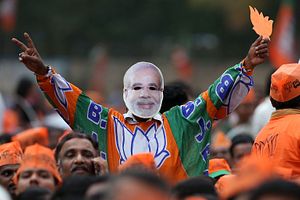Five hundred and fifty million – that is roughly how many people went to the polls for India’s last general election in 2014. The process was conducted in cycles covering different regions of the country and took a little over a month to complete. On “counting day” in mid-May, I recall sitting at my office in New Delhi watching the election results pour in with colleagues as we huddled in front of the office flat screen television. The atmosphere was tense and electric. State by state, the people of India were handing a clear mandate to the Bharatiya Janata Party (BJP), and specifically its face, Prime Minister-to-be Narendra Modi, to usher in a new era of prosperity and “acche din” (happy days). Nearly five years later, after an exhaustive series of new initiatives, policies, and institutions, the Indian electorate is about to judge the Modi government on whether he and his party have delivered on their promise of prosperity.
In the months leading up to the general election in 2014 people from the states of Jammu and Kashmir in the north to India’s southern coastal state of Kerala were bombarded with advertisements claiming that one man would help lift the country’s economy through a series of much needed reforms. Furthermore, these ads stipulated that in choosing the BJP at the polls, Narendra Modi, the party’s choice for leading the nation, would replicate the model of governance that had catapulted his home state of Gujarat to the forefront of industrial development in the country. Placing faith in individuals rather than parties was a style of election campaigning that was unique that year and mirrored the style used by President Barack Obama in the United States. The tactics employed, including extensive use of social media, volunteer canvassing and microtargeting of voters, helped oust from power the Indian National Congress (INC), a political party that had dominated Indian politics for decades. For the first time in India’s post-independence history a party other than the INC came to power with an overwhelming majority in India’s lower house, the Lok Sabha.
The question is, has this government accomplished enough with this majority to convince the voters to give them a second term?

































